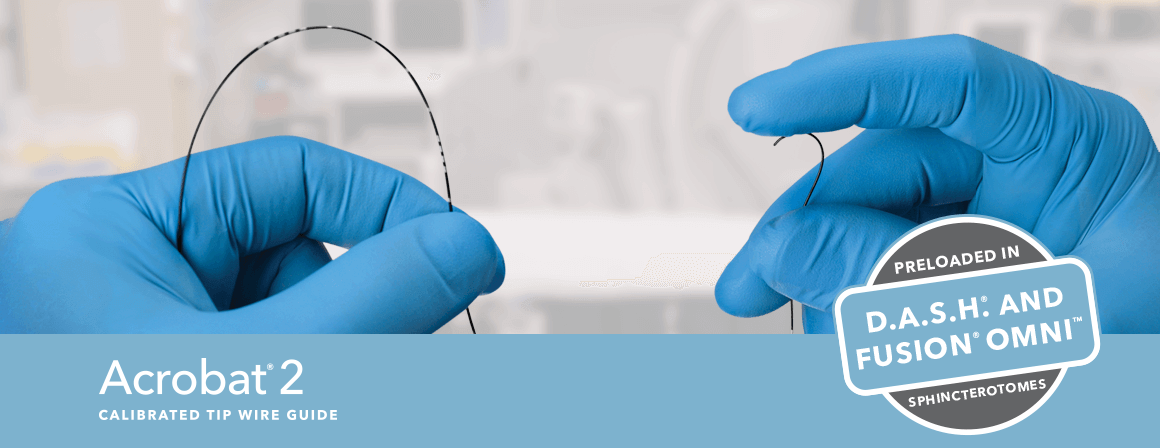Cook Medical has improved the Zilver 635 Biliary Stent, with a redesigned 6 Fr introducer and two new longer stent options (10 cm and 12 cm), to allow precise* endoscopic stent placement from the hilum through the papilla.
Here, Gregory Ginsberg, MD, performs a simultaneous double stenting procedure to palliate a patient with multifocal stricturing in the common bile duct and hilar strictures on both the left and right sides, resulting from a cholangiocarcinoma. During this procedure, he’s using two 12 cm Zilver 635 Biliary Stents over Acrobat® 2 Calibrated Tip Wire Guides.
Dr Ginsberg is the director of Endoscopic Services, professor of surgery, and professor of medicine at the Hospital of the University of Pennsylvania. His clinical expertise includes cholangiocarcinoma and biliary tract disorders.
6310765581112
brightcove
true
VIEW PRODUCT PAGE
REQUEST INFORMATION OR IN-SERVICE
Dr Gregory Ginsberg was not a paid consultant for Cook Medical at the time this video was made.
*ZILBS-635 verification testing on file for deployment accuracy. Test report document: D00057285.
Warning: The safety and effectiveness of this device for use in the vascular system have not been established.

Cook Medical has combined its premier technologies for access by preloading the new Acrobat® 2 Calibrated Tip Wire Guide in the D.A.S.H.™ and Fusion® OMNI™ Sphincterotomes. With this combination of our most advanced wire guide and sphincterotome technologies, you can benefit from greater procedural efficiency and consistent performance in the wide variety of situations you encounter every day.
Redefining ERCP access
Difficulty in cannulating the bile duct during endoscopic retrograde cholangiopancreatography (ERCP) is a risk factor for complications, which have been reported to occur in 9.8% of cases.¹ This number includes serious complications such as pancreatitis (5.4%) and haemorrhage (2.0%).¹ It has been suggested that a cannulation success rate greater than 95% and a complication rate less than 5% should be the standard for endoscopists when performing ERCP.²
Achieving such a low complication rate can be difficult, because ERCP is one of the most technically challenging procedures in endoscopy. That’s why tools that mitigate the challenges of accessing the ductal system are essential to bettering patient outcomes. The D.A.S.H. and Fusion OMNI sphincterotomes, when preloaded with the Acrobat 2 wire guide, provide the unique benefits of each device to address procedural difficulties without limiting the physician’s choice of technique.
Acrobat 2 delivers
The Acrobat 2 wire guide has a range of characteristics that endoscopists around the world told us they want in a wire guide:
- Tip flexibility—at least 35% greater tip flexibility than major competitors³
- Pushability—29% greater pushability than the original 0.035 inch diameter Acrobat4
- 1:1 torqueability—for precise wire guide rotation during selective cannulation and navigation of the ducts5
- Visualization of position and movement—the Mark V System® enables high-contrast visualization of movement and depth of insertion
For the long-wire technique
- The D.A.S.H. sphincterotome preloaded with the Acrobat 2 meets the needs of endoscopists who prefer the long-wire technique.
- The distal end of the D.A.S.H. features Cook Medical’s unique DomeTip®, which was designed with anatomy in mind for smooth access.
- The custom 3D forming stylet maintains a consistent orientation.
- The ergonomic handle provides the assistant with access to the wire guide, contrast, and cutting wire.
- The ability to inject over the wire guide gives the double-lumen D.A.S.H. triple-lumen functionality.
Go here to learn more about D.A.S.H.™ preloaded with Acrobat® 2.
For physician control
The Fusion OMNI preloaded with the Acrobat 2 meets the needs of endoscopists who prefer physician control of the wire guide.
- Like the D.A.S.H., the Fusion OMNI has DomeTip technology for smooth access.
- The custom 3D forming stylet maintains a consistent orientation.
- The solid, breakthrough channel design of this triple-lumen sphincterotome makes it possible to flush the wire guide lumen and for the endoscopist to control the wire guide.
Go here to learn more about Fusion® OMNI™ preloaded with Acrobat® 2.
Both of these preloaded Acrobat 2 options also streamline inventory, providing greater efficiency for materials management.
References
1. Freeman ML, Nelson DB, Sherman S, et al. Complications of endoscopic biliary sphincterotomy. N Engl J Med. 1996;335(13):909—918.
2. Mammen A, Haber G. Difficult biliary access: advanced cannulation and sphincterotomy technique.
Gastrointest Endosc Clin N Am. 2015;25(4):619—630.
3. Data on file at Cook Medical. Reference document number EA-RDE06032-004 Rev 1.
4. Data on file at Cook Medical. Reference document number EA-06028-01 Rev 1.
5. Data on file at Cook Medical. Reference document numbers RDE06031-06-R and RDE06031-05-R.

Dr Rehan Haidry and Dr Mohamed Hussein discuss the latest clinical data on the use of Hemospray Endoscopic Hemostat in haemostasis.
Click on a link below to watch the recording.
Video 1: Background on
the Clinical Registry
6238424432001
brightcove
true
Video 2: Clinical Registry Progression
and Emerging Trends
6238425552001
brightcove
true
Video 3: Patient Population
and Cases
6238424434001
brightcove
true
Video 4: Defining Combination Therapy vs Rescue Therapy
6238426538001
brightcove
true
Video 5: Peptic Ulcer Bleeding
6238427523001
brightcove
true
Video 6: Malignant Bleeding
6238425965001
brightcove
true
Video 7: Post-Endotherapy Bleeding
6238425966001
brightcove
true
Video 8: Audience Questions and Answers
6238425967001
brightcove
true
For more information on Hemospray, please visit hemospray.cookmedical.com.

Dr Rehan Haidry was a paid consultant for Cook Medical at the time this video was made.
Dr Mohamed Hussein was a paid consultant for Cook Medical at the time this video was made.
Endoscopic placement of self-expandable metallic stents (SEMS) has become an established treatment option in the palliation of biliary obstructions resulting from pancreaticobiliary disorders.
To discuss biliary stenting and recent developments in this area, we invited two experts in endoscopic retrograde cholangiopancreatography (ERCP) to share their experience and perspectives with us in this 3-part video series. In our third installment, Dr Raj J. Shah. and Prof Marco Bruno address the impact of new adjuvant therapies on endoscopic biliary stenting.
Refer to video one to hear Dr. Shah and Prof. Bruno discuss stent selection in common clinical settings, and video two to hear about their approach in the palliation of a hilar biliary obstruction compared to a distal obstruction.
6155121979001
brightcove
true
Learn more about Cook Medical’s line of biliary metal stents.

Dr Shah is professor of medicine and director of pancreas and biliary endoscopy at University of Colorado Anschutz Medical Campus.
Prof Bruno is professor of gastroenterology and head of the Department of Gastroenterology and Hepatology at Erasmus Medical Centre in Rotterdam.


